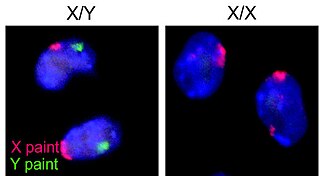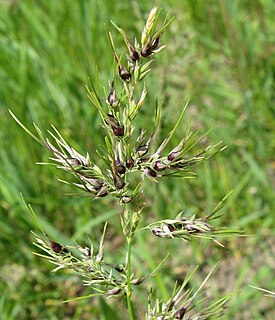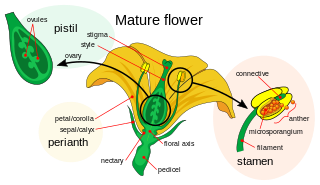Related Research Articles

Asexual reproduction is a type of reproduction which does not involve the fusion of gametes or change in the number of chromosomes. The offspring that arise by asexual reproduction from a single cell or from a multicellular organism inherit the genes of that parent. Asexual reproduction is the primary form of reproduction for single-celled organisms such as archaea and bacteria. Many multicellular animals, plants and fungi can also reproduce asexually.

A gamete is a haploid cell that fuses with another haploid cell during fertilization in organisms that sexually reproduce. In species that produce two morphologically distinct types of gametes, and in which each individual produces only one type, a female is any individual that produces the larger type of gamete—called an ovum— and a male produces the smaller tadpole-like type—called a sperm. In short a gamete is an egg cell or a sperm. This is an example of anisogamy or heterogamy, the condition in which females and males produce gametes of different sizes. In contrast, isogamy is the state of gametes from both sexes being the same size and shape, and given arbitrary designators for mating type. The name gamete was introduced by the German cytologist Eduard Strasburger. Gametes carry half the genetic information of an individual, one ploidy of each type, and are created through meiosis.

Meiosis is a special type of cell division in sexually-reproducing organisms used to produce the gametes, such as sperm or egg cells. It involves two rounds of division that ultimately result in four cells with only one copy of each chromosome (haploid). Additionally, prior to the division, genetic material from the paternal and maternal copies of each chromosome is crossed over, creating new combinations of code on each chromosome. Later on, during fertilisation, the haploid cells produced by meiosis from a male and female will fuse to create a cell with two copies of each chromosome again, the zygote.

Organisms of many species are specialized into male and female varieties, each known as a sex. Sexual reproduction involves the combining and mixing of genetic traits: specialized cells known as gametes combine to form offspring that inherit traits from each parent. The gametes produced by an organism define its sex: males produce small gametes while females produce large gametes. Individual organisms which produce both male and female gametes are termed hermaphroditic. Gametes can be identical in form and function, but, in many cases, an asymmetry has evolved such that two different types of gametes (heterogametes) exist.

Fertilisation or fertilization, also known as generative fertilisation, insemination, pollination, fecundation, syngamy and impregnation, is the fusion of gametes to initiate the development of a new individual organism or offspring. This cycle of fertilisation and development of new individuals is called sexual reproduction. During double fertilisation in angiosperms the haploid male gamete combines with two haploid polar nuclei to form a triploid primary endosperm nucleus by the process of vegetative fertilisation.

Pollen is a powdery substance consisting of pollen grains which are male microgametophytes of seed plants, which produce male gametes. Pollen grains have a hard coat made of sporopollenin that protects the gametophytes during the process of their movement from the stamens to the pistil of flowering plants, or from the male cone to the female cone of coniferous plants. If pollen lands on a compatible pistil or female cone, it germinates, producing a pollen tube that transfers the sperm to the ovule containing the female gametophyte. Individual pollen grains are small enough to require magnification to see detail. The study of pollen is called palynology and is highly useful in paleoecology, paleontology, archaeology, and forensics. Pollen in plants is used for transferring haploid male genetic material from the anther of a single flower to the stigma of another in cross-pollination. In a case of self-pollination, this process takes place from the anther of a flower to the stigma of the same flower.

In botany, apomixis was defined by Hans Winkler as replacement of the normal sexual reproduction by asexual reproduction, without fertilization. Its etymology is Greek for "away from" + "mixing". This definition notably does not mention meiosis. Thus "normal asexual reproduction" of plants, such as propagation from cuttings or leaves, has never been considered to be apomixis, but replacement of the seed by a plantlet or replacement of the flower by bulbils were categorized as types of apomixis. Apomictically produced offspring are genetically identical to the parent plant.

Gametogenesis is a biological process by which diploid or haploid precursor cells undergo cell division and differentiation to form mature haploid gametes. Depending on the biological life cycle of the organism, gametogenesis occurs by meiotic division of diploid gametocytes into various gametes, or by mitosis. For example, plants produce gametes through mitosis in gametophytes. The gametophytes grow from haploid spores after sporic meiosis. The existence of a multicellular, haploid phase in the life cycle between meiosis and gametogenesis is also referred to as alternation of generations.

In biology, a biological life cycle is a series of changes in form that an organism undergoes, returning to the starting state. "The concept is closely related to those of the life history, development and ontogeny, but differs from them in stressing renewal." Transitions of form may involve growth, asexual reproduction, or sexual reproduction.

In seed plants, the ovule is the structure that gives rise to and contains the female reproductive cells. It consists of three parts: The integument, forming its outer layer, the nucellus, and the female gametophyte in its center. The female gametophyte — specifically termed a megagametophyte— is also called the embryo sac in angiosperms. The megagametophyte produces an egg cell for the purpose of fertilization.
Microsporangia are sporangia that produce microspores that give rise to male gametophytes when they germinate. Microsporangia occur in all vascular plants that have heterosporic life cycles, such as seed plants, spike mosses and the aquatic fern genus Azolla. In gymnosperms and angiosperm anthers, the microsporangia produce microsporocytes, the microspore mother cells, which then produce four microspores through the process of meiosis. Microsporocytes are produced in the microsporangia of gymnosperm cones and the anthers of angiosperms. They are diploid microspore mother-cells, which then produce four haploid microspores through the process of meiosis. These become pollen grains, within which the microspores divide twice by mitosis to produce a very simple gametophyte.

Double fertilization is a complex fertilization mechanism of flowering plants (angiosperms). This process involves the joining of a female gametophyte with two male gametes (sperm). It begins when a pollen grain adheres to the stigma of the carpel, the female reproductive structure of a flower. The pollen grain then takes in moisture and begins to germinate, forming a pollen tube that extends down toward the ovary through the style. The tip of the pollen tube then enters the ovary and penetrates through the micropyle opening in the ovule. The pollen tube proceeds to release the two sperm in the megagametophyte.
A meiocyte is a type of cell that differentiates into a gamete through the process of meiosis. Through meiosis, the diploid meiocyte divides into four genetically different haploid gametes. The control of the meiocyte through the meiotic cell cycle varies between different groups of organisms.

Microspores are land plant spores that develop into male gametophytes, whereas megaspores develop into female gametophytes. The male gametophyte gives rise to sperm cells, which are used for fertilization of an egg cell to form a zygote. Megaspores are structures that are part of the alternation of generations in many seedless vascular cryptogams, all gymnosperms and all angiosperms. Plants with heterosporous life cycles using microspores and megaspores arose independently in several plant groups during the Devonian period. Microspores are haploid, and are produced from diploid microsporocytes by meiosis.
Plant reproduction is the production of new offspring in plants, which can be accomplished by sexual or asexual reproduction. Sexual reproduction produces offspring by the fusion of gametes, resulting in offspring genetically different from the parent or parents. Asexual reproduction produces new individuals without the fusion of gametes, genetically identical to the parent plants and each other, except when mutations occur.
Sporogenesis is the production of spores in biology. The term is also used to refer to the process of reproduction via spores. Reproductive spores were found to be formed in eukaryotic organisms, such as plants, algae and fungi, during their normal reproductive life cycle. Dormant spores are formed, for example by certain fungi and algae, primarily in response to unfavorable growing conditions. Most eukaryotic spores are haploid and form through cell division, though some types are diploid or dikaryons and form through cell fusion.

A megaspore mother cell, or megasporocyte, is a diploid cell in plants in which meiosis will occur, resulting in the production of four haploid megaspores. At least one of the spores develop into haploid female gametophytes (megagametophytes). The megaspore mother cell arises within the megasporangium tissue.

The tapetum is a specialised layer of nutritive cells found within the anther, of flowering plants, where it is located between the sporangenous tissue and the anther wall. Tapetum is important for the nutrition and development of pollen grains, as well as a source of precursors for the pollen coat. The cells are usually bigger and normally have more than one nucleus per cell. As the sporogenous cells undergo mitosis, the nuclei of tapetal cells also divide. Sometimes, this mitosis is not normal due to which many cells of mature tapetum become multinucleate. Sometimes polyploidy and polyteny can also be seen. The unusually large nuclear constitution of the tapetum helps it in providing nutrients and regulatory molecules to the forming pollen grains. The following processes are responsible for this:

Sexual reproduction is a type of reproduction that involves a complex life cycle in which a gamete with a single set of chromosomes (haploid) combines with another to produce an organism composed of cells with two sets of chromosomes (diploid). Sexual reproduction is the most common life cycle in multicellular eukaryotes, such as animals, fungi and plants. Sexual reproduction does not occur in prokaryotes, but they have processes with similar effects such as bacterial conjugation, transformation and transduction, which may have been precursors to sexual reproduction in early eukaryotes.

Hypericum punctatum, the spotted St. John's wort, is a perennial herb native to North America. The yellow-flowered herb occurs throughout eastern North America into southern Canada. The process of microsporogenesis carried out by this plant is prone to errors in chromosomal segregation. It has a diploid number of 14 or 16. Insects are attracted to the plant's pollen and the hypericin in the plant's leaves is toxic to mammals.
References
- ↑ Mursalimov S., Sidorchuk Yu., Deineko E. (2013) New insights into cytomixis: specific cellular features and prevalence in higher plants. Planta. 238:415–423.
- ↑ Arnoldy W (1900) Beiträge zur Morphologie der Gymnospermen. IV. Was sind die “Keimbläschen” oder “Hofmeisters-Körperchen” in der Eizelle der Abietineen? Flora 87:194–204.
- ↑ Gates RR (1911) Pollen formation in Oenothera gigas. Ann Bot 25:909–940.
- ↑ Guzicka M, Wozny A (2005) Cytomixis in shoot apex of Norway spruce [Picea abies (L.) Karst.]. Trees 18:722–724.
- ↑ Wang XY, Yu CH, Li X, et al. (2004) Ultrastructural aspects and possible origin of cytoplasmic channels providing intercellular connection in vegetative tissues of anthers. Russ J Plant Physiol 51:110–120.
- ↑ Lattoo SK, Khan S, Bamotra S, Dhar AK (2006) Cytomixis impairs meiosis and influences reproductive success in Chlorophytum comosum (Thunb) Jacq. – an additional strategy and possible implications. J Biosci 31:629–637.
- ↑ Kumar P, Singhal VK, Kaur D, Kaur S (2010) Cytomixis and associated meiotic abnormalities affecting pollen fertility in Clematis orientalis. Biologia Plantarum 54:181–184.
- ↑ Falistocco E, Tosti N, Falcinelli M (1995) Cytomixis in pollen mother cells of diploid Dactylis, one of the origins of 2n gametes. J Hered 86:448–453.
- ↑ Negron-Ortiz V (2007) Chromosome numbers, nuclear dna content, and polyploidy in Consolea (Cactaceae), an endemic cactus of the Caribbean Islands. Am J Bot 94:1360–1370.
- ↑ Singhal VK, Kumar P (2008) Impact of cytomixis on meiosis, pollen viability and pollen size in wild populations of Himalayan poppy (Meconopsis aculeata Royle). J Biosci 33:371–380.
- ↑ Singhal VK, Rana PK, Kumar P, Kaur D (2011) Persistent occurrence of meiotic abnormalities in a new hexaploid cytotype of Thalictrum foetidum from Indian cold deserts. Biologia 66:458–464.
- ↑ Mursalimov S., Sidorchuk Yu., Deineko E. (2013) New insights into cytomixis: specific cellular features and prevalence in higher plants. Planta. 238:415–423.